
Booze, Sailors & Health Menu: 1 2 3 4 5 6 7 8 9 10 11 12 13 14 15 16 17 18 19 Next>>
Booze, Sailors, Pirates and Health In the Golden Age of Piracy, Page 1
"And I... told my uncle sometimes that I had a great mind to go to sea; but my sister was against it and my uncle not very willing to it, knowing how many ill husbands and drunken fellows used to go to sea, and that it was a place where many ill vices were in practice; and thinking that it would not be for the best and that some trade would be more beneficial to me when
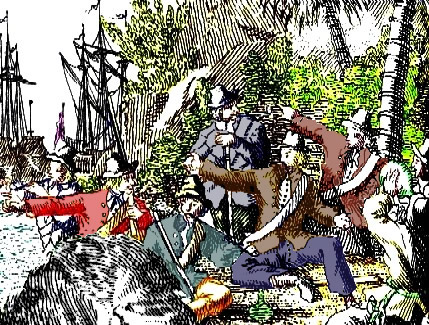
Edward Low's Men Drinking and Smoking, From Histoire der
Engelsche Zee-Roovers (1725)
I came to be old, and then I might have something to trust to." (Edward Barlow, Barlow’s Journal of his Life at Sea in King’s Ships, East and West Indiamen & Other Merchantman From 1659 to 1703, p. 28)
The link between sailors and indulging in booze when the opportunity presented itself is widely recognized, extending back before the golden age of piracy as Edward Barlow's above journal entry attests. The English appear to have a particular affinity for alcohol; speaking of England, historian Guy says, "Drunkenness, in the eighteenth century, was a condition that was accepted as inevitable"1. This propensity seemed to increase as they left home and ventured out into the wider world. In his contemporary history of Jamaica, Charles Leslie explained that the people of that island "live well, enjoy their Friend[s], drink heartily, make Money, and are quite careless of Futurity."2 Speaking of the British outpost at Barbados, Captain Thomas Walduck wrote to his nephew James Petiver in 1710 that "upon all the New Settlement, the Spaniards make, the first thing they do is build a church, the first thing ye Dutch do upon a New Colony is to build them a fort, but the first thing ye English doe, be it in the most remote part of ye world or amongst the most Barbarous Indians, is to set up a Tavern or drinking house."3
Drinking seems to have been even more popular on ships where even the British Royal Navy was given beer, wine and sometimes even brandy and rum as part of their daily fare. The 1731 naval regulations stated that the provisions on foreign voyages that "a Pint of Wine, or Half a Pint of Brandy, Rum, or Arrack [palm wine], hold Proportion to a Gallon of Beer" and one of these measures were to be allowed daily to the sailors.4
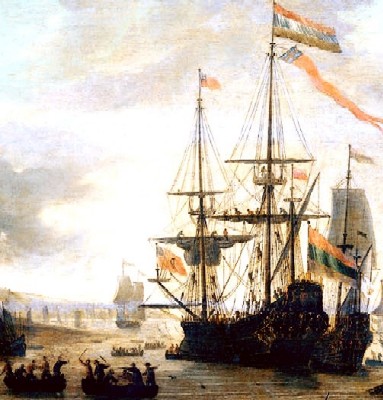
Artist: Jan van Leyden (1669)
This tradition was likely observed (and even expanded) on commercial vessels from the period. During a merchant voyage in 1702, Barlow was complaining about the captain of the East Indiaman Fleet Frigate. He ended his list of grievances noting that the man's worst crime was
selling the [ship's supply of] beer out at ‘Patavia’ [Batavia, modern Jakarta] and buying rack [arrack - locally made palm wine] and disposing of it as he pleased, and making us drink water all the time we were in China, and several times afterward, although it is a custom for men to be allowed rack to drink when there is done, a pint every day.5
Neither the navy nor merchantmen sailors can compete with the pirates, however. Where the former two had limits, pirates had none. As one example selected from among many others shows, after pirate captain George Lowther had taken a sloop in the Caribbean, they sailed it to a small island, where they "stay'd some Time to take their Diversions, which confided in unheard of Debaucheries, with drinking, swearing and rioting, in which there seemed to be a kind of Emulation among them, resembling rather Devils than Men, striving who should out do one another in new invented Oaths and Execrations."6
The first half of this article focuses on the alcohols and a few of the things associated with these alcohols which were used by sailors based on the period accounts of vessels. It will begin with a look at the containers used, briefly examine the concept of alcohol proofing and finish with a detailed look at the alcohols mentioned and their origins. The second half of the article focuses on the effects of alcohol on the sailors. The first third of this examines how alcohol was used by each type of sailor - naval, merchant and pirate - both at sea and in port. The second third of the second half of the article examines drunkenness among the various types of crews and results this produced. The last half of the article finishes with the surgeons' views on alcohol, both positive and negative,and how health problems associated with it were treated.
1 Guy Williams, The Age of Agony, 1986, p. 4; 2 Charles Leslie, A New History of Jamaica in Thirteen Letters, 1741, p. 1; 3 Thomas Walduck, "T. Walduck's Letters From Barbados, 1710", The Journal of the Barbados Museum and Historical Society, Volumes 15-17, 1947, p. 35; 4 Regulations and Instructions relating to His Majesty’s Service at Sea, 1731, p. 61; 5 Edward Barlow, Barlow’s Journal of his Life at Sea in King’s Ships, East and West Indiamen & Other Merchantman From 1659 to 1703, p. 540; 6 Captain Charles Johnson, A general history of the pirates, 2nd Edition, 1724, p. 358
Containers for Alcohol
There are two types of containers of interest with regard to alcoholic beverages: those used to ship it and those used to quaff it. Of the first, there was some consistency. Of the second, the specifics are less clear and difficult to verify, but can be pieced together using their (often brief) mentions in the period sea accounts, appearances in paintings and the extant examples which have survived and made their way to collections and museums.
Containers for Alcohol: Shipping
Among the types of shipping containers found in the period accounts, casks reign supreme. Many things shipped in barrels - salt meats, grains, dried foods, even crockery. Liquids were nearly always stored in these containers since they were "robust, durable, reliable, and hoistable."1 For liquids, 'tight' or 'wet' casks were used because they were designed to either keep liquid from getting in or out. Such wet casks were made from oak staves cut from trees averaging three feet in diameter using staves which were at least an inch thick.2
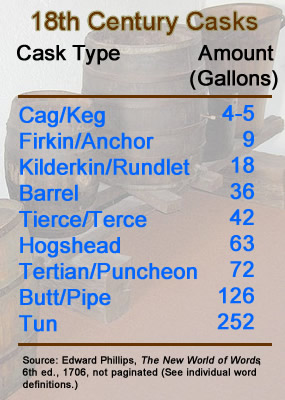
Background Photo: Georges Jansoone
Barrels came in a variety of sizes, each being called by a different name, many of which were mentioned in period documents. The list of standard casks and their capacity can be seen in the chart at left. (Note that these measurements are in imperial gallons, not US gallons.) Although these are fairly standard representations of cask types, this chart is still more of a rule of thumb than a strict measure. Since casks were built by hand by coopers, other sizes for each of these names appear in period documents. The actual cask sizes could also depend on the type of liquid it was built to contain. As late as 1897, Whitaker's Almanack explained that pipe sizes for wines varied by the type of wine the pipe contained: A pipe contained 115 gallons of port wine, 208 gallons of sherry, 100 gallons of Teneriffe wine, 93 gallons of Marsala wine, 92 gallons of Madeira and Cape wines.3
As if this weren't complicated enough, the size of casks used for wine and spirits were different from those used for beer during the golden age of piracy. A standard gallon of beer or ale contained 282 cubic inches while a gallon of wine or other spirits contained 231 cubic inches. The reasoning behind this was that ale foams while wine does not, so the ale measures were larger to account for the foam, insuring that the buyer did not have to pay for it.4
There are a variety of cask types mentioned in the period literature as it relates to sailors, suggesting that there was some recognition of relative sizes. Cags/Kegs are found filled with arrack5 and rum6 (referred to there as half-anchors), anchors were used to haul brandy7, 'half-barrels' (called 'kilderkins/rundlets' in the chart) contained rum8, barrels were used to transport wine9, hogsheads are mentioned in conjunction with wine10, rum11,
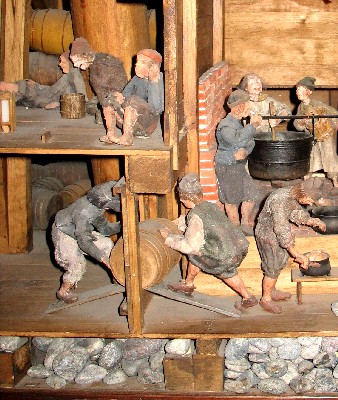
Photo: Peter Isolto - Vasa Model Showing Casks Below Decks
beer12, brandy13 and cider or ale14, butts are found containing beer15 and wine16, pipes are always mentioned in these sources in conjunction with wine17 and tuns were filled with brandy18 and beer19.
The shipping of wine and spirits sometimes had an added benefit. "The raw and acrid spirit that was poured into the keg emerged at the end of its journey mellowed and smoothed, with interesting amber colors and more delicate fragrances. Inadvertently, the very act of export created a higher-quality product."20 This was true for certain wines, such as Madeira, as well as for rum and brandy when they were shipped in oak casks. Contact with the wood would take the sharp edge off of spirits like rum.21 In addition, because the wooden casks were not perfectly liquid-proof, a certain amount of the spirit evaporated or leaked during shipment, particularly when the ship traveled through hot environments. This was what cognac-makers called 'the angel's share.' "Merchants and customs officers alike assumed that one gallon in twenty [of rum shipped from the Caribbean] would have gone by the time the rum reached North America, one in ten by British ports, and three gallons in twenty by the time it reached Africa."22 This dissipation contributed to improving the flavor of the alcohol.
Spirits were often distilled before they were shipped in casks in an effort to minimize the cost of shipping. The alcohol "was double or even triple distilled to save the cost of freight, and water would be added at the destination to get it to the appropriate and more drinkable strength."23 Once it had been cut, the booze was then put into bottles or other drinking containers, such as the customer desired.
The other shipping container that was sometimes used was the case bottle. (Round bottles are discussed in the next section.) Case bottles were particularly suited to shipping. They were tall, relatively thin green and brown glass containers with square bottoms which were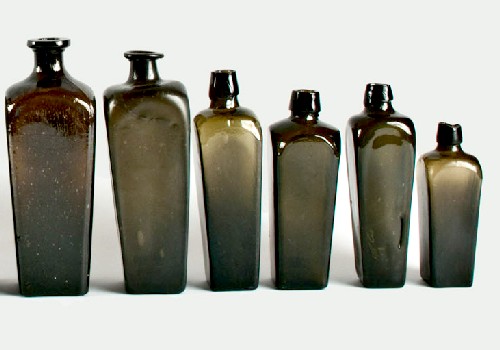
Several Green Case Bottles. Note the variety of sizes - standardization was not the norm.
designed to be put into wooden cases. (Hence their name.) Their square bottoms was a practical consideration; as sea surgeon John Moyle noted when discussing the choice of bottle types for the surgeon's medicine chest: "Let all your Jars and Glasses both great and small be square, and not round, that they may stow the better; and let them be all strong, double Glasses, that will not break upon a slight occasion."24
Bottles such as those seen here generally held "a capacity of about three-fifths of a quart, [and were] often referred to as 'Dutch gin bottles'."25 However, bottle-making was far from standardized (as can be seen in the image) and the capacity of any given bottle varied.
Case bottles would have been more expensive than barrels for hauling liquids and would have been less convenient for hauling large quantities of alcohols. Corks were hand-made and did not always fit tightly inside bottles during this period, so they were usually tied down with pack thread or
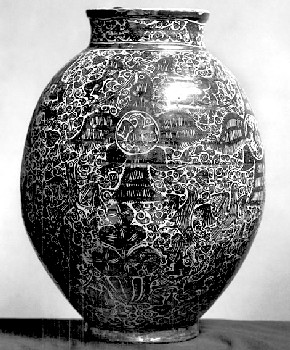
Mid-Late 17th Century Spanish Lusterware Storage Jar
even covered with melted wax to keep them in place "for fear of rising out, or taking vent"26. John Beale advised in 1664 that cider "should be drawn into well cork’d and well bound bottles"27. If the movement of the ship caused the corks to work their way out, it could ruin the shipment.
There is only one mention of case bottles in the pirate literature; Joseph Bicknor testified at the trial of mutineer John Whitcombe that he promised his cohorts that after the mutiny, "in case the Captain did not serve the Ships Company with Brandy, he would give every one concern'd a small Case Bottle of Spirits, out of the Ships Cargo"28. This suggests that the case bottles contained brandy rather than gin, although this is not made completely clear. (This notion is bolstered by the fact that gin was not generally found at sea among English sailors during this period.)
One other potential option for shipping alcoholic beverages is mentioned in the period sea accounts - large jars of earthenware. The one period example we have of this comes from an account of the land-based Spaniards in South America, who used such jars for storage in their household. During his privateering voyage around 1710 off the coast of South America, Woodes Rogers commented that “All over this Coast they use Jars instead of Casks, for Oil, Wine, and all other sorts of Liquids."29 However, the tone of this quote suggests this was considered unusual by the English and would likely not have been used by them to haul cargo.
1 Ian Williams, Rum, 2006, p. 215; 2 Raymond R. Townsend, "Coopers", Colonial Williamsburg Digital Library, gathered 5/8/17. For more on the construction of casks, see the section Casks in the article on Fresh Water at Sea During the Golden Age of Piracy; 3 Joseph Whitaker, An Almanack for the Year of Our Lord 1897, p. 424; 4 David Wondrich, Punch, 2010, p. 98; 5 “Mutiny on the Ship Adventure”, Pirates in Their Own Words, 2014, Ed Fox, ed., p. 254; 6 Daniel Defoe (Captain Charles Johnson), A General History of the Pyrates, Manuel Schonhorn, ed., 1999, p. 396; 7 “30. Alexander Thompson: The Information of Alexander Thompson, 2 March 1722.”, Pirates in Their Own Words, 2014, Ed Fox, ed., p. 142; 8 George Francis Dow and John Henry Edmonds, The Pirates of the New England Coast 1630-1730, 1996, p. 60;9 William Dampier, Memoirs of a Buccaneer, Dampier’s New Voyage Round the World -1697-, 1968, p. 362-3; 10 Charles Johnson, General History of the Pirates, 2nd ed., 1724, p. 353, Nathaniel Uring, A history of the voyages and travels of Capt. Nathaniel Uring, 1928, p. 241 & Dampier, Memoirs, 1968, p. 44 & 70; 11 Johnson, General History, p. 95 & 361, "The Tryals of Major Stede Bonnet...”, Pirates in Their Own Words, p. 100, “30. Alexander Thompson, "The Information of Alexander Thompson 2 May, 1722. HCA 1/55 ff. 23-24”, Pirates in Their Own Words, Ed Fox, ed., 2014, p. 142, & Jeremy Roch, from Bruce S. Ingram, Three Sea Journals of Stuart Times, 1936, p. 127; 12 Nathaniel Boteler, Boteler's Dialogues, 1929, p. 57-8 & “William Phillips ...”, Pirates in Their Own Words, p. 29; 13 Johnson, General History, p. 103 & Dampier, Memoirs, 1968, p. 70; 14 Uring, p. 241; 15 John J. Keevil, Medicine and the Navy, Volume II, p. 173; “27.16 Barlow, p. 53; 17 Barlow, p. 53, Uring, p. 223, “28. The petition of John Massey and George Lowther, from EXT 1/261, ff. 197-199", Pirates in Their Own Words, Ed Fox, ed., 2014, p. 133, Captain Charles Johnson, The History of the Pirates, 1829, p. 103 & “28. The petition of John Massey and George Lowther, from EXT 1/261, ff. 197-199", Pirates in Their Own Words, Ed Fox, ed., 2014, p. 133; 18 The Boston News-Letter, Monday August 15 to Monday August 22. 1720; 19 Boteler, p. 58; 20 Williams, p. 215; 21 Williams, p. 214; 22 Williams, p. 217; 23 Williams, p. 94; 24 John Moyle, Abstractum Chirurgæ Marinæ, p. 14; 25 Eleanor S. Godrey, The Development of English Glassmaking, 1560-1640, 1975, p. 228; 26 Gervase Markham, The English Hus-wife, 1615; 27 John Beale, “Aphorisms Concerning Cider”, Printed in John Evelyn’s Sylva, 1664, p. 29, For more on container closures, see this page; 28 The Tryals of Captain John Rackham, and Other Pirates, 1721, p. 41; 29 Woodes Rogers, A Cruising Voyage Round the World, 1712, p. 148;

